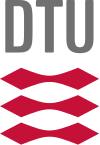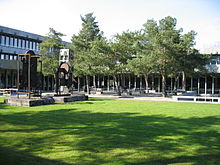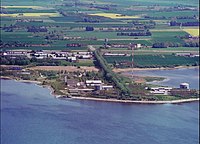

Danmarks Tekniske Universitet
| |
 | |
Other name | DTU |
|---|---|
Former names | Den Polytekniske Læreanstalt (1829–1933) Danmarks Tekniske Højskole (1933–1994) |
| Motto | Technology for people |
| Type | Public, Technical |
| Established | November 5, 1829; 194 years ago (1829-11-05) |
| Chairman | Karin Markides |
| President | Anders Bjarklev |
| Provost | Rasmus Larsen |
| Dean | Philip Binning and Martin Vigild |
| Director | Claus Nielsen |
| Senior Vice President | Marianne Thellersen and Carsten Orth Gaarn-Larsen |
Academic staff | 2,003[1] |
Administrative staff | 1,540[1] |
| Students | 11,031[2] |
| Undergraduates | 7,197[2] |
| Postgraduates | 3,834[2] |
| 1,330[2] | |
| Location |
Lyngby, Lyngby-Taarbæk Municipality, Copenhagen
,
Denmark
|
| Affiliations | EUA, TIME, CESAER and EuroTech |
| Website | www.dtu.dk/ |
 | |
The Technical University of Denmark (Danish: Danmarks Tekniske Universitet), often simply referred to as DTU, is a polytechnic university and school of engineering. It was founded in 1829 at the initiative of Hans Christian Ørsted as Denmark's first polytechnic, and it is today ranked among Europe's leading engineering institutions. It is located in the town Kongens Lyngby, 12 kilometres (7.5 mi) north of central Copenhagen, Denmark.
Along with École Polytechnique in Paris, École Polytechnique Fédérale de Lausanne, Eindhoven University of Technology, Technical University of Munich and Technion – Israel Institute of Technology, DTU is a member of EuroTech Universities Alliance.[3]
DTU was founded in 1829 as the "College of Advanced Technology" (Danish: Den Polytekniske Læreanstalt). The Physicist Hans Christian Ørsted, at that time a professor at the University of Copenhagen, was one of the driving forces behind this initiative. He was inspired by the École Polytechnique in Paris, France which Ørsted had visited as a young scientist. The new institution was inaugurated on 5 November 1829 with Ørsted becoming its Principal, a position he held until his death in 1851.[4]

The first home of the new college consisted of two buildings located in Studiestræde and St. Pederstræde in the center of Copenhagen. Although these buildings were expanded several times, they eventually became inadequate for the requirements of the college. In 1890 a new building complex was completed and inaugurated located in Sølvgade. The new buildings were designed by the architect Johan Daniel Herholdt.[4]
In 1903, the College of Advanced Technology commenced the education of electrical engineers in addition to that of the construction engineers, the production engineers, and the mechanical engineers who already at that time were being educated at the college.
In the 1920s, space again became insufficient and in 1929 the foundation stone was laid for a new school at Østervold. Completion of this building was delayed by World War II and it was not completed before 1954.[4]
From 1933, the institution was officially known as Danmarks tekniske Højskole (DtH), which commonly was translated into English, as the 'Technical University of Denmark'. On 1 April 1994, in connection with the joining of Danmarks Ingeniørakademi (DIA) and DTH, the Danish name was changed to Danmarks Tekniske Universitet, this done to include the word 'University' thus giving rise to the initials DTU by which the university is commonly known today. The formal name, Den Polytekniske Læreanstalt, Danmarks Tekniske Universitet, however, still includes the original name.

In 1960 a decision was made to move the College of Advanced Technology to new and larger facilities in Lyngby north of Copenhagen. They were inaugurated on 17 May 1974.[4]
On 23 and 24 November 1967, the University Computing Center hosted the NATO Science Committee's Study Group first meeting discussing the newly coined term "Software Engineering".[5]
On 1 January 2007, the university was merged with the following Danish research centers: Forskningscenter Risø, Danmarks Fødevareforskning, Danmarks Fiskeriundersøgelser (from 1 January 2008: National Institute for Aquatic Resources; DTU Aqua), Danmarks Rumcenter, and Danmarks Transport-Forskning.
The university is governed by a board consisting of 10 members: Six members are recruited from outside the university and they form the majority of the board. One member is appointed by the scientific staff and one member is appointed by the administrative staff. Two members are appointed by the university students.
The President of DTU is appointed by the university board. The President in turn appoints the Deans, and the Deans appoint the Heads of the departments.
In 2014, DTU was granted institutional accreditation by the Danish Accreditation Institution (a member of ENQA). The institutional accreditation ensures that the quality assurance system of the institution is well-described, well-argued, and well-functioning in practice.
Since DTU has no faculty senate, and since the faculty is not involved in the appointment of the President, Deans, or Department heads, the university has no faculty governance.[6]

DTU Diplom is the university's graduate engineering department (Danish: Center for Diplomingeniøruddannelse). Its facilities are located in Ballerup across 42.000 m2 of space designed by PLH Architects.
The institution was first established in 1881, as an independent university college known as Copenhagen University College of Engineering (Danish: Ingeniørhøjskolen i København). The University College of Engineering merged with DTU in 2013, at which point it became the school's graduate engineering department.[8]
The National Space Institute at the Technical University of Denmark, also known as DTU Space (Danish: Institut for Rumforskning og Rumteknologi), is a Danish sector research institute within DTU.[9][10] The institute conducts research in astrophysics, Solar System physics, geodesy, and space technology in collaboration with the Niels Bohr Institute for Astronomy, Geophysics and Physics. The institute currently leads Swarm, a project to investigate the properties of the Earth's magnetic field.[11]
The institute was first established in 2005 as the Danish National Space Center through the merger of the Danish Space Research Institute and the geodesy part of the National Survey and Cadastre of Denmark. In 2008, the National Space Center was integrated into DTU, becoming DTU Space. It has a staff of 169, including researchers, engineers, and technicians.[12]
DTU Vet is located at the 40,000 square metre DTU Life Science and Bioengineering Center on DTU's main campus in Lyngby.[13] The institution was first established in 1908 as the Royal Veterinary and Agricultural University’s Serum Laboratory (Danish: Den Kgl. Veterinær- og Landbohøjskoles Serumlaboratorium) at the initiative of professor C. O. Jensen. In 1932, its name was changed to the National Veterinary Serum Laboratory (Statens Veterinære Serumlaboratorium).[14] In 2002, the National Veterinary Serum Laboratory merged with the National Veterinary Institute for Virus Research (established 1926) to form the Danish Veterinary Institute (Danmarks Veterinærinstitut). The Veterinary Institute was then merged with part of the Danish Veterinary and Food Administration in 2004, forming the Danish Institute for Food and Veterinary Research (DFVF). In 2007, the institute merged with DTU, forming DTU's veterinary department.
The Department of Mathematics (Danish: Institut for Matematik, MAT) is located in building 303 S at Matematiktorvet, quadrant 3 on Lundtoftesletten in Lyngby. It was founded to consolidate all mathematical research and teaching at DTU. The institute The research at Department of Mathematics covers both theoretical and applications issues and is currently centered on four main areas: discrete mathematics, dynamical systems, applied functional analysis, and geometry.
All undergraduate students at DTU receive at least 20 ECTS points worth of classes from the Department of Mathematics during their first year. Master thesis projects and PhD projects are also completed in collaboration with private companies.
The department participates in several research networks. Along with the Department of Mechanical Engineering, the applied functional analysis team participates in a research network on topology optimization, referred to as TOPOPT. TOPOPT is sponsored by a NEDO grant and a European Young Investigator award (EURYI).Along with University of Southern Denmark, the Department of Mathematics organises an annual European Study Group with Industry (ESGI), where a weeklong workshop is centered on finding solutions to mathematical modelling problems brought forth by the industry.

The Center for Electron Nanoscopy (Danish: Center for Elektronnanoskopi, CEN) is a center for electron microscopy within the university.[15] Inaugurated in December 2007, the institute was funded by a donation of DKK100 million from the A.P. Møller and Chastine Mc-Kinney Møller Foundation.[16] DTU CEN houses seven electron microscopes built by FEI Company ranging from a standard scanning electron microscope to two highly specialized Titan transmission electron microscopes. The microscopes are available for use by both in-house and external users. They are housed in a new building designed especially for the microscopes, 314, and the offices are located on the first floor of the neighbouring building, 307.[17]

The university is located on a plain known as Lundtoftesletten in the northeastern end of the city of Lyngby. The area was previously home to the airfield Lundtofte Flyveplads. The campus is roughly divided in half by the road Anker Engelunds Vej going in the east–west direction, and, perpendicular to that, by two lengthy, collinear roads located on either side of a parking lot. The campus is thus divided into four parts, referred to as quadrants, numbered one through four in correspondence with the conventional numbering of quadrants in the Cartesian coordinate system with north upwards.
The Risø Campus (55°41′35″N 12°05′54″E / 55.69306°N 12.09833°E / 55.69306; 12.09833) is a satellite campus north of Roskilde which covers an area of more than 2.6 square kilometres. It houses a number of DTU's institutes, as well as Aarhus University's Department of Environmental Science and Department of Bioscience. The campus was formerly the site of the Risø National Laboratory for Sustainable Energy (Danish: Nationallaboratoriet for bæredygtig energi), a scientific research organization established in 1956 and merged into DTU in 2007, before finally being dissolved on 1 January 2012.
Wind Atlas Analysis and Application Program (WAsP) is a tool used in the wind energy industry to simulate wind flow over terrain and estimate the long-term power production of wind turbines and wind farms. It has been in development by Risø and DTU Wind Energy for over 30 years, and runs on PCs using Microsoft Windows.

The Risø National Laboratory for Sustainable Energy had been founded in 1956 under the leadership of Niels Bohr.[18] The laboratory employed about 700 staff in 2005, at which point it was a research institute under the Danish Ministry of Science, Technology and Innovation. On 1 January 2007, the Technical University of Denmark (DTU) merged with several national research institutes, including the Risø National Laboratory. The following year in 2008, it was made an official institute of DTU. On 1 January 2012 the institute was dissolved and its facilities were transformed into a separate campus.
In its first three decades, the Risø National Laboratory's activities were centred around research on peaceful use of nuclear energy and was the site of three research nuclear reactors: DR-1, DR-2 and DR-3. All three reactors are no longer in use, and have undergone decommissioning since 2003.[19] DR1 was a Homogenous reactor with a thermal power of 2kW, operational 1957–2001 and decommissioned between 2003 and 2006. DR2 was a pool reactor with a thermal power of 5MW, operational 1958–1975 and decommissioned in 2003. DR3 was a DIDO with a thermal power of 10MW, operational 1960–2000 and also decommissioned in 2003.
In its later years[when?], the organization's focus shifted towards other energy sources, and was particularly noted for its involvement in wind energy and solid-oxide fuel cells. The National Laboratory had strong competences in climate change effects studies and had "state of the art" facilities for realistic climate change experiments and monitoring. These included the Risø Environmental Risk Assessment facility, a phytotrone controlled environment growth facility; the Sorø beech forest, a field station in an 80-year-old beech forest measuring carbon inputs, outputs and turnover processes by advanced techniques (e.g. eddy covariance); and CLIMAITE, a field scale climate change experiment conducting multifactor experiments with elevated CO2, night time warming and altered precipitation. The laboratory's facilities were also used by the National Environmental Research Institute of Denmark (Danish: Danmarks Miljøundersøgelser) until 2011 when it too was dissolved.

The Campus Village is an international student housing complex on the university's Lyngby campus at Elektrovej 330.[20] It houses up to 224 international students, most of them staying for the duration of a semester or an academic year, and it is made up of identical red containers arranged in rows, housing up to ten students each.[21][22] The Campus Village was constructed in the summer of 2001, and was opened as an international student dormitory starting in fall 2001.[23] Residents staying in Campus Village may be participants of exchange or bilateral agreement programs between DTU and their home university.
DTU was the subject of controversy in 2009 because the (then) institute director of the Department of Chemistry, O.W. Sørensen,[24] was a high-ranking member of Scientology.[25] In relation to this, the university was accused of violating the principles of free speech by threatening to fire employees, among them Rolf W. Berg, who voiced their criticism of the institute director.[26][27][28][29][30][31] On 7 April 2010, the successor of Sørensen was announced, at a department meeting, as Erling Stenby,[32] who officially took over as Director on 1 May 2010.
This section needs to be updated. Please help update this article to reflect recent events or newly available information. (March 2024)
|
| University rankings | |
|---|---|
| Global – Overall | |
| ARWU World[33] | 151–200 (2023) |
| QS World[34] | 121 (2024) |
| THE World[35] | 126 (2024) |
The university maintains an updated site with the university's standing in several relevant academic and research rankings. In November 2007 the Times Higher Education Supplement put the university as number 130 in their ranking of the universities of the world and number 122 in 2010.[36]
Exiles RUFC is the official rugby union club of DTU.[42]
168-year-old Polyteknisk Forening, as well as the maritime student association Nul-kryds formed in 1947.[citation needed]
This article's list of people may not follow Wikipedia's verifiability policy. Please improve this article by removing names that do not have independent reliable sources showing they merit inclusion in this article AND are members of this list, or by incorporating the relevant publications into the body of the article through appropriate citations. (April 2021)
|
{{cite web}}: CS1 maint: archived copy as title (link)
|
| |||||||
|---|---|---|---|---|---|---|---|
| Africa |
| ||||||
| Asia-Pacific |
| ||||||
| Europe |
| ||||||
| North America |
| ||||||
Central and |
| ||||||
|
| |
|---|---|
| Austria |
|
| Belgium |
|
| China |
|
| Czechia |
|
| Denmark |
|
| Finland |
|
| France |
|
| Germany |
|
| Greece |
|
| Hungary |
|
| Italy |
|
| Norway |
|
| Poland |
|
| Portugal |
|
| Russia |
|
| Spain |
|
| Sweden |
|
| Switzerland |
|
| Turkey |
|
| UK |
|
| |
55°47′09″N 12°31′17″E / 55.78583°N 12.52139°E / 55.78583; 12.52139
| International |
|
|---|---|
| National |
|
| People |
|
| Other |
|